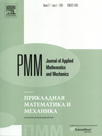 | | Journal of Applied
Mathematics and Mechanics
Russian Academy of Sciences | | Founded
in January 1936
(Translated from 1958)
Issued 6 times a year
ISSN 0021-8928
(print version) |
Archive of Issues
| Total articles in the database: | | 10610 |
| In Russian (ΟΜΜ): | | 9811
|
| In English (J. Appl. Math. Mech.): | | 799 |
|
| << Previous article | Volume 80, Issue 3 / 2016 | Next article >> |
| V.V. Vedeneev, "Propagation of waves in a layer of a viscoelastic material underlying a layer of a moving fluid," J. Appl. Math. Mech. 80 (3), 225-243 (2016) |
| Year |
2016 |
Volume |
80 |
Issue |
3 |
Pages |
225-243 |
| DOI |
10.1016/j.jappmathmech.2016.07.004 |
| Title |
Propagation of waves in a layer of a viscoelastic material underlying a layer of a moving fluid |
| Author(s) |
V.V. Vedeneev (M.V. Lomonosov Moscow State University, Moscow, Russia, vasily@vedeneev.ru) |
| Abstract |
The motion of waves in a layer of a viscoelastic material of finite thickness with a layer of an ideal incompressible fluid moving over it is considered in connection with the problem of the turbulent friction reduction in a boundary layer by using compliant coatings. The dispersion equation is obtained, and the behaviour of its roots is analysed. It is proved that when the flow velocity exceeds a certain value, two types of instability appear: a weaker instability, which is caused by the viscous properties of the material and vanishes in the purely elastic case, and a stronger instability, which is present in the case of an elastic material. The stability criteria of short and long waves are found in analytical form, and it is shown numerically for both types of instability that among all wavelengths the smallest critical velocity is achieved on short waves, whose stability criterion thus gives the stability criteria of all waves. The resonance wavelengths at which the interface undergoes strictly vertical vibrations are analysed. A resonance wavelength equal to 3-5 thicknesses is scarcely influenced by the fluid; nevertheless, a second resonance with a wavelength equal to 5-20 thicknesses appears when the fluid is present. The results obtained are used to estimate the influence of a moving fluid on the effectiveness of compliant coatings used to reduce turbulent friction. |
| Received |
02 December 2014 |
| Link to Fulltext |
|
| << Previous article | Volume 80, Issue 3 / 2016 | Next article >> |
|
 If you find a misprint on a webpage, please help us correct it promptly - just highlight and press Ctrl+Enter If you find a misprint on a webpage, please help us correct it promptly - just highlight and press Ctrl+Enter
|
|

 Russian
Russian  English
English